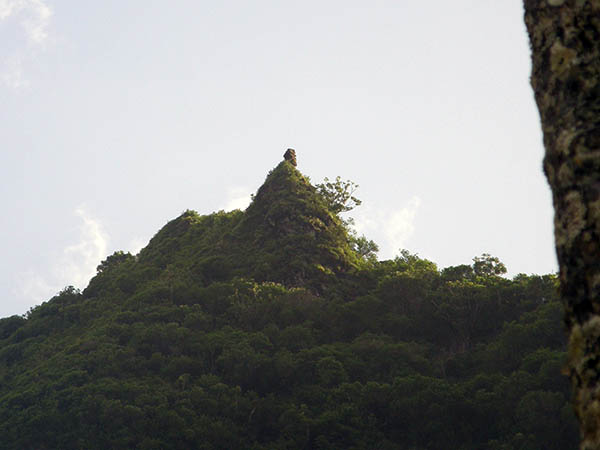 |
"Most anthropological, archaeological, and historical accounts of Hawai‘i assume the first aboriginal people came as voyagers,” Carlos tells us. “Hawaiian oral traditions contain many accounts of long-distance voyages from various islands and archipelagoes lying far to the south. However, other stories suggest the Hawaiian people have always been in residence. Accounts gathered in the late 1800s and early 1900s from elders on Kaua‘i propose the earliest inhabitants of Hā’ena might have been there long before voyagers from the south ventured into these northern seas. These people of great antiquity, known as Menehune, are recognized by some as the original people of these islands.
“J.A. Akina traveled around the island of Kaua‘i. He recorded stories about Menehune, collected from the memories of elders at the time. Traveling through the outlying districts, he recorded stories attached to the rocks and surrounding land. His unpublished manuscript, now in the possession of descendants of an early missionary family, some of whom maintain residences in Hā‘ena, is the basis for much that is known about these mysterious people.”
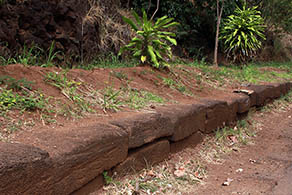
The Menehune Ditch, near Waimea, on the Southern shore. This is one of two man-made features on the Kaua‘i landscape that is attributed to the Menehune. The stonework used in building the ditch is unlike anything found anywhere else in the Hawaiian Islands. Photo by Joseph Patrick Gray, 2013.
According to that story, “In ancient times there was only one landmass extending from Hawai‘i far south to Samoa and Rarotong Zealand and perhaps Fiji. This great land, known as Ka-houpo-o-Kane, was a low land of plains, sparsely interspersed with mountains. The ocean surrounding this land was known as Moana-nui-kai-oo. In the time of the ali‘i (traditional leader), Hinali‘i, a great volcanic cataclysm occurred. In the aftermath, the ocean inundated the lowlands, causing this land to be cut up and divided by the sea. Today, all that remains of Ka-houpo-o-Kane are the heaped-up rocks (previously mountains on the land of plains) now known as the various archipelagoes of Oceania.
“The narrative mentions two peoples, Ke-na-mu and Ke-na-wa, who lived on Kaua‘i in those primeval times. According to the account, they were destroyed completely by the Menehune and an ali‘i, Kualu-nui-kini-akua, who arrived later from Kahiki-ka-paia-haa, also known as Kahiki moe (perhaps Tahiti, or other lands in the south). This ali‘i was the great-grandfather of Ola; many stories about him are attached to places in the western districts of Kaua‘i.
“Contained in this excerpt is the ancient name of Kaua‘i, Ka-ma-wae-lua-lani, which is not in common use today. This name alludes to the story of god-like, ancestral relatives of the Hawaiian people, Papa (hānaumoku-earth mother giving birth to islands) and Wākea (sky father). In the Papa and Wākea story, Papa became disenchanted with Wākea after giving birth to Hawai‘i and Maui islands, and left him for another lover, Lua (Beckwith 1970: 302). The child born of this union was O‘ahu island. Eventually, Papa returned to Wākea, renewing the relationship, and gave birth to Kaua‘i island. Māwae means to split or separate. Lani, meaning majestic or heavenly, is also an epithet for a royal or highborn person.
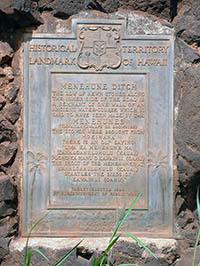
Plaque honoring the tradition of the Menehune Ditch
"Thus the ancient name Ka-mawae-lua-lani commemorates the separation of Lua and Papa and Papa's reconciliation with Wākea. This reference to the story of Papa and Wākea embedded in the name Kamawaelualani shows a curious intermingling of traditions. Menehune accounts about themselves allude to the great antiquity of their residence, but the story of the mating of earth mother and sky father, told in other versions throughout Oceania, seems to belong to the more recent traditions of the descendants of voyagers from Kahiki.”
According to Joesting (1984:20-1) the Tahitians had once been known in their homeland as Manahune, a slight dialectical variation of Menehune: “They bore the name with honor until Tahiti was conquered by warriors from Raiatea, when it took on a very different meaning. Manahune became the name for a commoner and a term of derision. In the Hawaiian Islands, seizing the positions of leadership, the Tahitians labeled the original settlers Menehune, a repetition of what the Raiateans had done to them.
“The following Tahitian mele is in disdain of the Manahune.
Go to the mountains where you belong,
Far, far away from there;
Far away where the red skies lie,
Away to the road of separation,
Far away to the clustering yellow bamboos,
Torch-fisher of the nato of Motutu,
Picker of eels,
Thou art the grandchild of the mountain,
Thou slave of the Arii
“The Marquesans had no such word as Manahune in their vocabulary. In the Marquesas the word for commoner was maka‘ainana, which became the accepted word in Hawaii for a commoner, or a person who tended to land.”
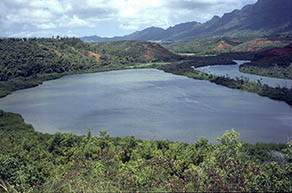
The Menehune Fishpond, near Līhu‘e.
“Though stories of the Menehune are attached to numerous places located in all the districts of Kaua‘i island,” Carlos continues, “and to various places on other Hawaiian islands as well, Hā‘ena seems to be the last place where Menehune gathered in large numbers. In the broad, flat lands between the hill Kea‘alewalewa and the valley Limahuli, they planted foodstuffs in all of the depressions, hills, ravines, and valleys large and small, close to the bird gathering lands of Kahuku.
"According to these accounts, the offspring of these plantings still provided food and sustenance for the people of Hā‘ena well into historic times. Conversations with the kupa‘āina (longtime residents) of Hā‘ena reveal that hunters and gatherers continue to enjoy the fruits of these plantings until this day.
“The reason given for the gathering of the Menehune in the environs of Hā‘ena is that the so-called ‘king’ of the Menehune tells his people he wants to get them all together and they’re going to leave, because he doesn’t like the idea of his people, of the Menehune men folk, marrying Hawaiian women and having children with Hawaiian women, which apparently they were doing in enough numbers to alarm him.
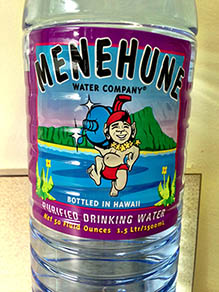
"Menehune water," one of many uses of a caricatured, elf-like menehune found on stores and products in Hawaii, especially on Kauai."
“In contemporary times, storytellers from other lands transformed the Menehune into little people strongly resembling Irish leprechauns or fairies and elves of European forests,” Carlos points out. “If the Menehune were, as some writers have described them, two feet tall, with bushy hair, distended stomachs, and a guttural language, would Hawaiian women have married them? How are men two and a half and three feet tall—all these dwarves—going to marry regular Hawaiian women in such numbers? Why are these Hawaiian women marrying all these dwarves? So, that's a question that remains unresolved. The physical shrinking of Menehune in stories written in historic times by foreign writers may have more to do with Westerners’ imaginations than with the actual physical stature of these people.”
When and how this idea of the Menehune as small developed is uncertain, but it appears at least as far back as a 1908 local Hawaiian treatise on the subject. The combination of low social stature (or physical height) with living back in the mountains that this Tahitian mele suggests, also appears in the case of the Menehune of Kaua‘i. The census takers of Kaumulai‘i, ruling chief of Kaua‘i in the early 19th century, registered 65 persons as Menehune among the 2000 recorded inhabitants of Wainiha Valley. The record refers to “The 65 men of Lā‘au”, which is the place in the very back of Wainiha valley, the valley next to Hā‘ena that extends so far back into the heart of the island. Carlos suggests that this location is not accidental, but that displaced peoples are pushed further and further inland.
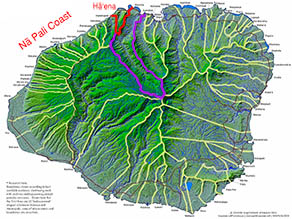
Hā‘ena's neighboring valley, Wainiha, reaches deep into the heart of the island.
“The Menehune, some of them at least, went into isolation,” Carlos says. “And according to this census, in the time of Kaumuali‘i, which is the time of Kamehameha—of Captain Cook—there were 65 people who self-identified as Menehune. They were real people. So when you think about people who have been here for 2000 years, and people who are self-declared as Menehune who have been here even longer, there are definitely those who assimilated, who married and had children.
“So there is a whole group of people who have the genes and blood running through them of the people who have been here even longer than the Hawaiians have been here. The classic idea, the James Michener idea of bronze Polynesians coming here and settling this empty land, its not quite that simple.”
|
 |















